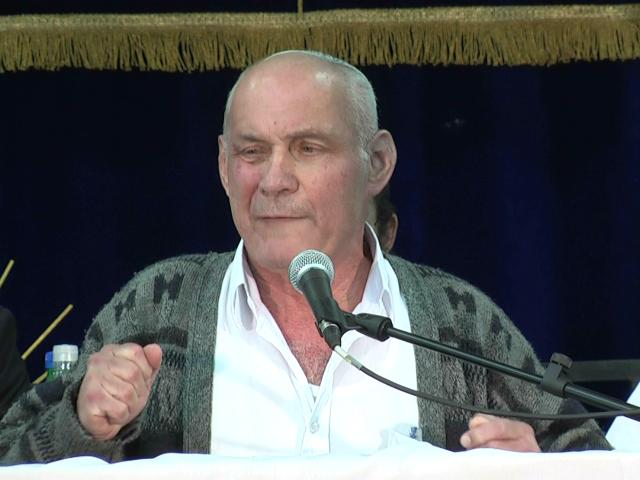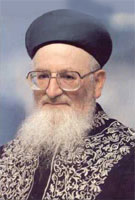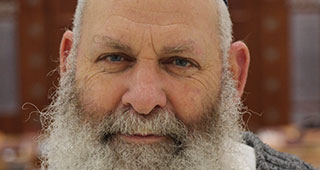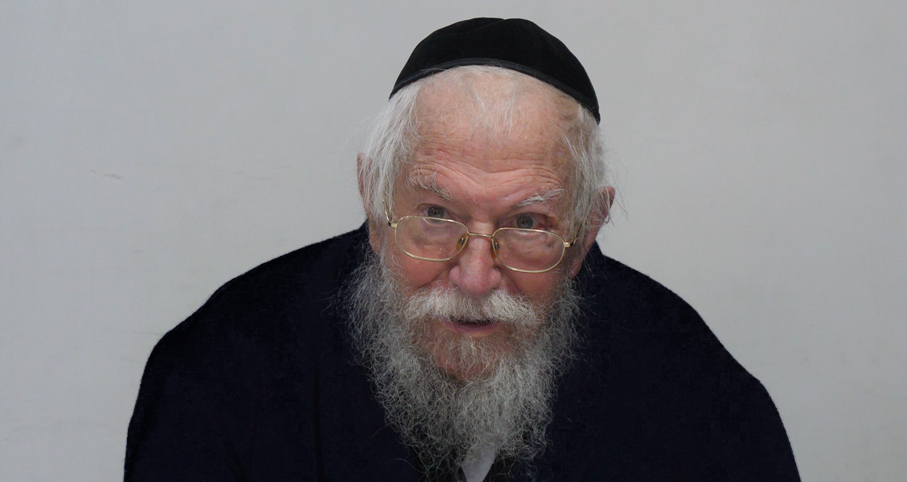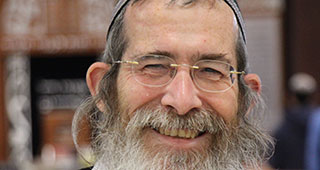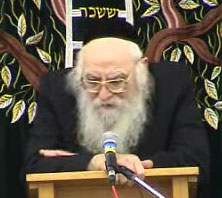Beit Midrash
- Torah Portion and Tanach
- Shmot
- Beshalach
Question #1: My son
"We were returning home in an area without an eruv, when my two-year old decided that he was walking no farther. Is there a halachically acceptable way for me to carry him home?"
Question #2: Public safety
"There is something dangerous lying in the street. May we remove it on Shabbos before anyone gets hurt?"
Question #3: Tefillin
"While taking a Shabbos stroll through the woods outside my town, I discovered some pairs of tefillin lying on the ground! Presumably, these were taken by thieves who broke into a shul, but subsequently abandoned them. Is there any way that I can bring these tefillin back to town?"
Answer:
All of the above questions involve carrying something on Shabbos in a place where there is no eruv. Our topic will be whether there is a halachic basis to permit carrying under these circumstances. As always, the purpose of this article is not to render decisions for our readers, but to introduce background and have the reader refer any related questions to his or her rav or posek. But first, some basic background.
What is "carrying"?
As we know, one of the 39 melachos of Shabbos is hotza’ah, which is violated by transporting an item from a reshus harabim, a public thoroughfare or open marketplace, into a reshus hayachid, an enclosed area, or, vice versa, by transporting from a reshus hayachid to a reshus harabim. The melacha also includes carrying or otherwise transporting items four amos (about seven feet) or more within a reshus harabim (Shabbos 96b; Tosafos, Shabbos 2a s.v. pashat). With reference to the laws of Shabbos, the terms reshus hayachid and reshus harabim are not determined by ownership, but by the extent to which the area is enclosed and how it is used. An area could be either publicly-owned or ownerless and still qualify as a reshus hayachid; an area owned by an individual might still qualify as a reshus harabim.
Akirah and hanacha
Violating this melacha min haTorah is defined by three steps.
(1) The first step is called akirah, literally, uprooting, which means removing the item from a place where it is at rest. The item must be at rest before the melacha is performed. "At rest" does not have to mean that it is on the ground – it could be resting on an item or piece of furniture, and, sometimes could even be "resting" in someone’s hand. Removing it from its "place of rest" qualifies as an akirah.
(2) The second step is the actual movement of the item, as described above.
(3) The final step is called hanacha, placing, which means that when the melacha activity is completed, the item is again "at rest."
Let me use the first Mishnah of Maseches Shabbos for examples that explain these rules: One person, whom we will call "the outsider," is standing in a reshus harabim, picks up an item that is located in the reshus harabim and passes it to someone in a reshus hayachid, "the insider." If the outsider places the item into the hand of the insider, then the outsider has violated Shabbos – he (1) performed the akirah, (2) transported the item from a reshus harabim into a reshus hayachid and (3) performed the hanacha. Placing the item into the insider’s hand is considered hanacha, since the item is now "at rest," and, when it reaches its resting point, it is in the reshus hayachid.
However, if the outsider merely extends his hand containing the item into the reshus hayachid, and the insider takes the item from the outsider’s hand, neither of them has performed a Torah violation of Shabbos. Although the outsider performed akirah and moved the item into the reshus hayachid (thereby performing steps 1 and 2), he did not complete the hanacha (step 3). Since the item was still in the suspended hand of the outsider, who himself was standing in a different area, it is not considered to be at rest in a reshus hayachid.
In this situation, the Mishnah explains that neither the outsider nor the insider has violated a melacha min haTorah. Nevertheless, both have violated rabbinic prohibitions, because Chazal prohibited performing akirah without hanacha and also prohibited performing hanacha without akirah. In addition, Chazal prohibited carrying something in the reshus harabim without either akirah or hanacha, and transporting something from a reshus hayachid to a reshus harabim, or vice versa, without akirah or hanacha.
Akirah and hanacha both within a reshus harabim
Similarly, the Torah’s prohibition to carry something or otherwise transport it four amos or more within a reshus harabim is only when there is both an akirah and a hanacha. If one transports it more than four amos, but did not perform both an akirah and a hanacha, the prohibition is only miderabbanan. Thus, if someone picks up an item in a reshus harabim, carries it four amos, but did not stop, and a different person removes it from his hand, neither of them has desecrated Shabbos min haTorah, although both violated rabbinic prohibitions for performing part of the melacha act.
What is a hanacha?
Here is another example of a case where no hanacha was performed. Someone picks up a bundle in a reshus harabim, places it on his shoulder, and walks with it more than four amos. At this point, he stops to adjust the bundle. The Gemara (Shabbos 5b) teaches that this is not considered a hanacha, and therefore the person has not desecrated Shabbos min haTorah.
However, if the person carrying the bundle stopped to rest, it is considered hanacha. (We will explain shortly what we mean that he "stopped to rest.") Therefore, if he performed an akirah, carried a bundle more than four amos in a reshus harabim and then stopped to rest, he has performed a melacha, whereas if he stopped simply to rearrange his bundle and then continued on his way, he did not yet perform a melacha.
Less than four amos
In addition to the requirements of akirah and hanacha, one violates the melacha of carrying within a reshus harabim only when one transports the item at least four amos. Carrying an item less than four amos, called pachos mei’arba amos, in a reshus harabim does not violate Torah law. Whether this is prohibited by the Sages is the subject of a dispute among tana’im. According to the Rambam, it is permitted even miderabbanan to move an item less than four amos in a reshus harabim, whereas according to the Raavad, this is prohibited miderabbanan, except in extenuating situations.
A lenient hanacha
Until now, both akirah and hanacha have been sources of stringency, meaning that they have created a Torah prohibition, and without both of them, one does not violate the melacha of carrying min haTorah. However, there is actually a leniency that can be created by performing a hanacha. Here is the case: Someone transported an item less than four amos through a reshus harabim and then performed a hanacha, thereby completing this act of carrying. He then performs a new akirah and carries the item an additional short distance, but again less than four amos. Although, as we will soon see, it is prohibited to do this on Shabbos, there is no violation min haTorah; each time he carried the item, it was for less than four amos, since the two acts were separated by a hanacha.
Pachos pachos
What is the halacha regarding the following scenario: Reuven notices an item in a reshus harabim that he would like to move to a different location, more than four amos from where it currently is. He knows that it is prohibited min haTorah for him to pick it up, move it there, and put it down in its new location, since this constitutes akirah, moving it more than four amos, and hanacha. Instead, Reuven decides to do the following: he will pick up the item, move it less than four amos and put it down. Although he did both an akirah and a hanacha, since he moved the item less than four amos, this does not constitute a Torah violation, and, according to many rishonim, it is permitted lechatchilah. However, moving the item less than four amos does not accomplish what Reuven wants. In order to get the item to where he would like it to be, Reuven performs this process again – that is, he picks it up, moves it less than four amos, and puts it down again. This type of carrying is called pachos pachos mei’arba amos, meaning that although each time he carries the item he transports it less than four amos, he carries it this way more than one time. Reuven would like to repeat this process until he gets the item where he wants it. Is this permitted?
Indeed, Reuven’s plan will avoid desecrating a Torah prohibition of Shabbos, since he has successfully avoided performing melacha. However, Chazal prohibited someone from transporting an item this way out of concern that he may err, even once, and carry the item four amos or more and then perform the hanacha, thereby violating Shabbos min haTorah (Shabbos 153b).
However, the Gemara mentions that, under certain extraordinary circumstances, someone is permitted to transport an item in this manner. For example, someone walking through a reshus harabim discovers a pair of tefillin! He is concerned that, should he leave the tefillin where they are, they will be desecrated. The Gemara rules that, should the finder have no other option, he may transport the tefillin to a secure place via pachos pachos (Eruvin 97b). In other words, in order to avoid the desecration of the tefillin, Chazal relaxed the prohibition of carrying pachos pachos.
Babies and thorns
Similarly, the Gemara discusses this in the context of a baby who is outside of an eruv, and permits use of the heter of pachos pachos to transport him to an appropriate place.
In yet another example, the Gemara permits removing a thorn from a reshus harabim so that no one gets hurt (Shabbos 42a). Again, in an extenuating situation, Chazal permitted one to carry this way, even though it is usually not permitted.
At this point, we can address a different one of our above questions: "There is something dangerous lying in the street. May we remove it before anyone gets hurt?"
The answer is that one may remove it by carrying it less than four amos, stopping, and then repeating, as described above.
Must he sit down?
As I explained above, transporting something pachos pachos can be accomplished only when there is a proper hanacha to divide the two carrying acts into two separate halachic activities. What constitutes a proper hanacha in this instance?
There is a dispute between rishonim whether, in this instance, the person transporting the tefillin must sit down, or whether it is sufficient that he stop to rest while remaining standing. Rashi (Avodah Zarah 70a) rules that it is sufficient for someone to stop to rest within four amos of his last stop. He does not explain how long he must rest for it to be considered a hanacha.
There are those who disagree with Rashi, contending that stopping to rest qualifies as a hanacha only when one truly wants to rest. However, when one’s goal is not to rest, but simply to avoid desecrating Shabbos, stopping of this nature while still standing does not constitute hanacha. According to this opinion, to avoid the prohibition of carrying on Shabbos, the tefillin transporter must actually sit down to qualify as having performed hanacha (Rabbeinu Yerucham, quoted by Beis Yosef, Orach Chayim 266 and 349, as explained by Magen Avraham 266:9).
How do we rule?
There is a dispute among early acharonim whether we follow Rashi or Rabbeinu Yerucham in this matter, but the majority follow Rashi’s approach that stopping to rest is adequate as a hanacha, even in this situation (Darchei Moshe, Orach Chayim 266:1; Magen Avraham 266:9; cf. Taz, Orach Chayim 266:4 who rules like Rabbeinu Yerucham).
Found tefillin
At this point, we can address one of our opening questions: "While taking a Shabbos stroll through the woods outside my town, I discovered some pairs of tefillin lying on the ground! Presumably, these were taken by thieves who broke into a shul, but subsequently abandoned them. Is there any way that I can bring these tefillin back to town?"
In this context, the Gemara rules that if one cannot safely remain with the tefillin until Shabbos ends, one may bring them back via the method of pachos pachos, meaning that one carries the tefillin for less than four amos, stops to rest, and then continues. According to Rabbeinu Yerucham, one should actually sit down when one stops to rest, whereas according to Rashi, this is unnecessary.
Karmelis
Until this point, we have been discussing the halachic rules that exist min haTorah, and we have dealt with areas that are either reshus harabim or reshus hayachid. However, there are many areas that do not qualify as either reshus harabim or reshus hayachid. A reshus harabim must be meant for public use or thoroughfare (Shabbos 6a) and must also meet other specific requirements, which I discussed in a different article. Any area that does not meet the Torah’s definition of a reshus harabim, and yet is not enclosed, is called a karmelis. Min haTorah, one may carry inside, into and from a karmelis. However, Chazal ruled that a karmelis must be treated with the stringencies of both a reshus hayachid and a reshus harabim. This means that it is forbidden to carry inside, into, or from any area that is not completely enclosed. This is the way we are familiar with observing Shabbos – one does not carry in any unenclosed area.
Nevertheless, the Gemara rules that there are exceptional situations when Chazal permitted one to carry in a karmelis. The Gemara mentions explicitly that should one find a thorn in a karmelis that might hurt someone, one can simply pick it up and remove it, since the prohibition of carrying within and out of a karmelis is only miderabbanan.
Pachos pachos in a karmelis
Is it permitted to carry pachos pachos in a karmelis? In other words, since carrying in a karmelis is, itself, prohibited only miderabbanan, and carrying pachos pachos in a reshus harabim is prohibited only miderabbanan, if we combine both of these aspects in one case, is it permitted to carry?
This question is discussed neither in the Gemara nor by most of the rishonim. Although there are several attempts to demonstrate proof one way or the other from the Gemara and the early authorities, none of the proofs is conclusive. There is a dispute among the later authorities, many contending that pachos pachos is prohibited in a karmelis (Tashbeitz 2:281; Shulchan Aruch, Orach Chayim 349:5; Gra), whereas others feel that there should be no halachic problem at all with carrying pachos pachos in a karmelis (Even Ha’ozer and Maamar Mordechai, Orach Chayim 349; Shu"t Avodas Hagershuni #104). Common practice is to prohibit carrying pachos pachos in a karmelis, following the ruling of the Shulchan Aruch.
Conclusion
Let us now examine our opening question: "We were returning home in an area without an eruv when my two-year old decided that he was walking no farther. Is there a halachically acceptable way for me to carry him home?"
According to what we have now learned, even if the area in question qualifies as a reshus harabim, if one were to pick up the child, carry him less than four amos, and then stop, this would be permitted under the circumstances. Assuming that there are two people to carry the child, there is even a better solution, one that space-constraints does not allow us to explain fully, and that is to have the two people hand the child from one to the other and back without either walking four amos at any given time. There is also another reason to be lenient in the case of a child old enough to walk, in that carrying him in a reshus harabim is not prohibited min haTorah, because of a principle called chai nosei es atzmo, which we will have to leave for a future article.
Difference of carrying
The melacha of hotza’ah, carrying, is qualitatively different from the other 38 melachos. Every other melacha results in some type of change, either physical or chemical, to the item on which the melacha is performed. In the case of carrying, the only thing being changed is the item’s location. Furthermore, the rules governing what is permitted min haTorah and what violates Torah law seem strange and arbitrary. Yet, we understand that these rules are part of our Torah shebe’al peh, and we have to study to learn how to apply them. The Navi Yirmiyohu (17:19-27) was concerned about carrying on Shabbos; it is a melacha like any other, yet people mistakenly think that it is not important. Indeed, we would not usually define transporting something as changing it functionally, which is what most melachos accomplish. Yet, this does not make the melacha of hotza’ah any less important than any other melacha.
Rav Hirsch (Shemos 35:2) explains that whereas other melachos demonstrate man’s mastery over the physical world, carrying demonstrates his mastery over the social sphere. The actions that show the responsibility of the individual to the community and vice versa are often acts of hotza’ah. Thus, the prohibition to carry on Shabbos is to demonstrate man’s subordination to Hashem, in regard to his role and position in his social and national life.
This Shiur is published also at Rabbi Kaganof's site

The Staircase of Faith in the Weekly Portion
Rabbi Avraham Shapira Zt"l | 16 Shvat 5784
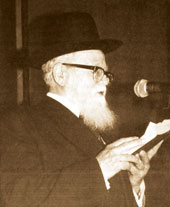
Song of Men, Not Angels
From Siach Shaul, p. 224-5
Rabbi Shaul Yisraeli zt"l | 5772

The Basics of Techum Shabbos
Rabbi Yirmiyohu Kaganoff | Shvat 10 5777





